Blog
Arthritis Can Cause Pain in the Feet and Ankles
Bunion Treatment

Bunions are a common foot problem that can be painful and frustrating. A bunion can occur when the bone or tissue at the base of the big toe moves out of place, causing discomfort, swelling, and difficulty in finding comfortable shoes. While bunions cannot be reversed without surgery, there are effective non-surgical treatments that can help to reduce pain and improve foot health. Bunions can be caused by factors such as wearing poorly fitting footwear, foot weaknesses, and genetics. Some individuals are more at risk, and people with certain foot types or who wear tight shoes may be affected. Non-surgical treatments for bunions include wearing shoes with a wide toe box and performing foot exercises to strengthen and increase flexibility. Additionally, using orthotics or bunion pads may help provide moderate relief. Surgery is considered to be a last resort for severe cases of bunions when non-surgical treatments fail to provide relief. Various surgical procedures can correct bunions, but there is a risk of recurrence. Implementing lifestyle changes such as choosing appropriate footwear, maintaining a healthy weight, practicing foot exercises, and avoiding high-impact activities can reduce the risk of developing bunions. If you experience discomfort from a bunion, it is suggested that you make an appointment with a podiatrist for a treatment plan that is right for you.
If you are suffering from bunion pain, contact one of our podiatrists of The Podiatry Center, PC. Our doctors can provide the care you need to keep you pain-free and on your feet.
What Is a Bunion?
Bunions are painful bony bumps that usually develop on the inside of the foot at the joint of the big toe. As the deformity increases over time, it may become painful to walk and wear shoes. Women are more likely to exacerbate existing bunions since they often wear tight, narrow shoes that shift their toes together. Bunion pain can be relieved by wearing wider shoes with enough room for the toes.
Causes
- Genetics – some people inherit feet that are more prone to bunion development
- Inflammatory Conditions - rheumatoid arthritis and polio may cause bunion development
Symptoms
- Redness and inflammation
- Pain and tenderness
- Callus or corns on the bump
- Restricted motion in the big toe
In order to diagnose your bunion, your podiatrist may ask about your medical history, symptoms, and general health. Your doctor might also order an x-ray to take a closer look at your feet. Nonsurgical treatment options include orthotics, padding, icing, changes in footwear, and medication. If nonsurgical treatments don’t alleviate your bunion pain, surgery may be necessary.
If you have any questions, please feel free to contact our office located in Millburn, NJ . We offer the newest diagnostic and treatment technologies for all your foot care needs.
Foot Care and Falls Prevention
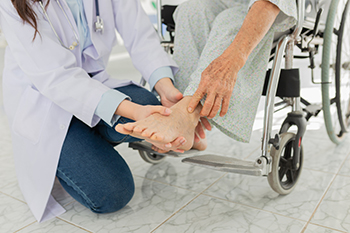
When considering the well-being of elderly loved ones, it is essential not to overlook the health of their feet, as they play a vital role in supporting their mobility. Foot problems among seniors are common and often associated with weakness, altered gait, and balance difficulties, which can increase the risk of falls. Various foot issues can affect older individuals and can include corns, calluses, and toenail disorders. Additionally, bunions and deformities such as hammertoe and claw toe may develop. Loss of fat pads and connective tissue disorders can also lead to discomfort. Poor circulation and systemic conditions, such as diabetes and arthritis, can further compound foot problems. Proper elderly foot care involves regular checks for changes in foot health, maintaining cleanliness, and ensuring proper footwear fit. Orthotics can help alleviate foot pain and reduce fall risks in the elderly as well. If you are elderly or taking care of a senior, it is suggested that you make an appointment with a podiatrist to help maintain regular foot care, in addition to providing advice on effective fall prevention techniques.
Proper foot care is something many older adults forget to consider. If you have any concerns about your feet and ankles, contact one of our podiatrists from The Podiatry Center, PC. Our doctors can provide the care you need to keep you pain-free and on your feet.
The Elderly and Their Feet
As we age we start to notice many changes in our body, but the elder population may not notice them right away. Medical conditions may prevent the elderly to take notice of their foot health right away. Poor vision is a lead contributor to not taking action for the elderly.
Common Conditions
- Neuropathy – can reduce feeling in the feet and can hide many life-threatening medical conditions.
- Reduced flexibility – prevents the ability of proper toenail trimming, and foot cleaning. If left untreated, it may lead to further medical issues.
- Foot sores – amongst the older population can be serious before they are discovered. Some of the problematic conditions they may face are:
- Gouging toenails affecting nearby toe
- Shoes that don’t fit properly
- Pressure sores
- Loss of circulation in legs & feet
- Edema & swelling of feet and ankles
Susceptible Infections
Diabetes and poor circulation can cause general loss of sensitivity over the years, turning a simple cut into a serious issue.
If you have any questions please feel free to contact our office located in Millburn, NJ . We offer the newest diagnostic and treatment technologies for all your foot and ankle needs.
Gout Pain Can Be Managed
Healing From a Broken Toe

A broken toe can be a painful and frustrating experience, but with patience and proper care, it can mend successfully. The first step in healing a broken toe is to seek medical attention from a podiatrist for an accurate diagnosis and to rule out any complications. Once diagnosed, the primary focus is on rest and protection. This often involves wearing a splint, cast, or buddy taping, which is taping the broken toe to the toe next to it. This is generally successful in immobilizing the injured area. Elevating the foot can help reduce swelling, while taking over-the-counter pain relievers can manage discomfort. Avoid putting weight on the affected toe and opt for comfortable, supportive footwear. Healing times can vary but typically range from a few weeks to a couple of months. As your toe begins to mend, performing several range of motion exercises that can aid in recovery is beneficial. If you have broken your toe, it is suggested that you are under the care of a podiatrist who can guide you toward the best treatment methods for you.
A broken toe can be very painful and lead to complications if not properly fixed. If you have any concerns about your feet, contact one of our podiatrists from The Podiatry Center, PC. Our doctors will treat your foot and ankle needs.
What to Know About a Broken Toe
Although most people try to avoid foot trauma such as banging, stubbing, or dropping heavy objects on their feet, the unfortunate fact is that it is a common occurrence. Given the fact that toes are positioned in front of the feet, they typically sustain the brunt of such trauma. When trauma occurs to a toe, the result can be a painful break (fracture).
Symptoms of a Broken Toe
- Throbbing pain
- Swelling
- Bruising on the skin and toenail
- The inability to move the toe
- Toe appears crooked or disfigured
- Tingling or numbness in the toe
Generally, it is best to stay off of the injured toe with the affected foot elevated.
Severe toe fractures may be treated with a splint, cast, and in some cases, minor surgery. Due to its position and the pressure it endures with daily activity, future complications can occur if the big toe is not properly treated.
If you have any questions please feel free to contact our office located in Millburn, NJ . We offer the newest diagnostic and treatment technologies for all your foot and ankle needs.
Treatment Options for Flat Feet
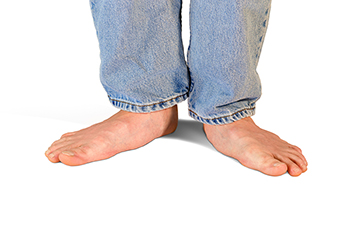
Flat feet is a condition where the arch of the foot is either too low or nonexistent. As a rule, flat feet are rarely considered to be medically serious. However, flat feet can sometimes lead to discomfort or complications, and some type of treatment may be necessary. If you are experiencing pain around the ankle or aching in the arch of the foot, it may be time to consider treatment. Additionally, if you notice that your shoes are wearing out quickly, it could be a sign that your flat feet are causing undue stress on your footwear. Non-surgical treatment includes changing footwear, investing in orthotic inserts for improved arch support, and performing certain exercises to improve the strength and flexibility of the foot muscles. These can potentially reduce pain and discomfort. Prescription painkillers may be recommended to manage pain and any stiffness associated with flat feet. When other treatments have failed or if there's a structural issue with the bones, tissues, or muscles in the feet, surgery may be considered as a last resort. For guidance about treatment options for flat feet, it is suggested that you consult a podiatrist.
Flatfoot is a condition many people suffer from. If you have flat feet, contact one of our podiatrists from The Podiatry Center, PC. Our doctors will treat your foot and ankle needs.
What Are Flat Feet?
Flatfoot is a condition in which the arch of the foot is depressed and the sole of the foot is almost completely in contact with the ground. About 20-30% of the population generally has flat feet because their arches never formed during growth.
Conditions & Problems:
Having flat feet makes it difficult to run or walk because of the stress placed on the ankles.
Alignment – The general alignment of your legs can be disrupted, because the ankles move inward which can cause major discomfort.
Knees – If you have complications with your knees, flat feet can be a contributor to arthritis in that area.
Symptoms
- Pain around the heel or arch area
- Trouble standing on the tip toe
- Swelling around the inside of the ankle
- Flat look to one or both feet
- Having your shoes feel uneven when worn
Treatment
If you are experiencing pain and stress on the foot you may weaken the posterior tibial tendon, which runs around the inside of the ankle.
If you have any questions please feel free to contact our office located in Millburn, NJ . We offer the newest diagnostic and treatment technologies for all your foot and ankle needs.
Are Bunions Affecting Your Everyday Life?
Medicines That Help Prevent Gout
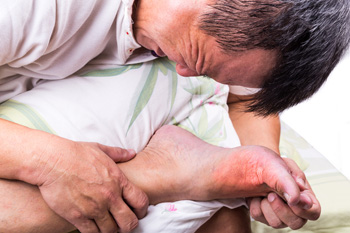
Gout, a form of arthritis, is characterized by painful joint swelling due to a buildup of uric acid in the bloodstream. It often affects the big toe as well as other joints. Failing to address gout can lead to lasting joint damage. Treatment for gout involves lifestyle adjustments, including alcohol avoidance and weight management, along with medication. During acute attacks, non-steroidal anti-inflammatory drugs, NSAIDs, can alleviate pain and swelling, though they don't impact uric acid levels. Corticosteroids, taken orally or injected into affected joints, also offer relief. Colchicine, an alternative to NSAIDs, lessens inflammation if taken early. To prevent future gout occurrences, medications are used to lower uric acid levels in the body. Xanthine oxidase inhibitors limit uric acid production, while uricosuric medicines increase its elimination via urine. It is important to be aware of the adverse effects of any medication. For help with the management of gout, it is suggested that you keep in communication with a podiatrist, who is specifically trained to deal with such problems.
Gout is a foot condition that requires certain treatment and care. If you are seeking treatment, contact one of our podiatrists from The Podiatry Center, PC. Our doctors will treat your foot and ankle needs.
What Is Gout?
Gout is a type of arthritis caused by a buildup of uric acid in the bloodstream. It often develops in the foot, especially the big toe area, although it can manifest in other parts of the body as well. Gout can make walking and standing very painful and is especially common in diabetics and the obese.
People typically get gout because of a poor diet. Genetic predisposition is also a factor. The children of parents who have had gout frequently have a chance of developing it themselves.
Gout can easily be identified by redness and inflammation of the big toe and the surrounding areas of the foot. Other symptoms include extreme fatigue, joint pain, and running high fevers. Sometimes corticosteroid drugs can be prescribed to treat gout, but the best way to combat this disease is to get more exercise and eat a better diet.
If you have any questions please feel free to contact our office located in Millburn, NJ . We offer the newest diagnostic and treatment technologies for all your foot and ankle needs.
Plantar Fasciitis May Be Helped With Shockwave Therapy
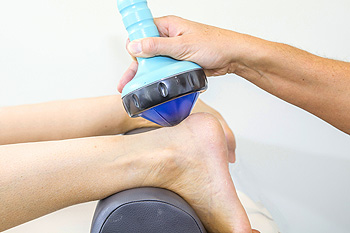
A small percentage of people who have plantar fasciitis experience little or no positive response to ordinary treatment. An option to consider may be to have Extracorporeal Shock Wave Therapy (ESWT) performed. This can be a successful treatment for this type of foot condition. Shockwave therapy is administered by targeting shock waves into the damaged tissue surrounding the plantar fascia. This procedure generally takes about 20 minutes and anesthesia is typically not needed if the treatment is low impact. Conversely, with high-intensity treatment, general anesthesia may be needed as a result of the pain that may be felt. Patients have experienced little or no downtime after the session, however, several treatments may be needed for permanent relief. Possible side effects may include swelling, redness, and slight bruising at the treatment site. If you suffer from heel pain, please consult with a podiatrist who can determine if shockwave therapy is right for you.
Shockwave therapy is a treatment commonly used to treat various injuries and conditions, particularly plantar fasciitis in the feet. To learn more, consult with one of our podiatrists from The Podiatry Center, PC. Our doctors can provide the care you need to keep you pain-free and on your feet.
Shockwave Therapy
Shockwave therapy is a new treatment option designed to treat bone conditions such as tennis elbow, shoulder pain, and others. Shockwave therapy uses high intensity sound waves that are directed to the affected tissues of the body with pinpoint accuracy. The effects are very beneficial, leading to a production of collagen fibers, eliminating inflammation.
Who Benefits from Shockwave?
Shockwave is recommended for patients suffering from heel pain and associated problems. Heel pain is a common condition which can be caused by obesity, overexertion, and spending a substantial amount of time on hard floors with your feet exposed and unsupported.
Fast and Easy
The therapy is actually a simple process that can leave patients feeling better the very next day. Shockwave therapy is not as dramatic as it sounds. It enables more blood flow to effected areas, addressing the source of the problem and allowing treatment to last for a long time.
Treatment & Recovery Time
Shockwave treatment will enable your feet to recover quickly. This is especially important since surgery is not required. It is cost effective and does not require the use of anesthesia. This treatment is a better option to surgery, since it is proven safe.
If you have any questions, please feel free to contact our office located in Millburn, NJ . We offer the newest diagnostic and treatment technologies for all your foot and ankle needs.
Are You Suffering From Ingrown Toenails?
More...
Causes and Treatments for Ingrown Toenails

Within the world of common foot woes, ingrown toenails stand as a painful and bothersome issue that can disrupt daily life. These occur when the edges of a toenail grow into the surrounding skin, leading to inflammation and discomfort. Often stemming from improper nail trimming, wearing tight footwear, or genetic reasons, ingrown toenails can bring about pain, swelling, and possibly infection. Treating this condition involves gentle soaking, proper nail trimming techniques, and wearing comfortable, well-fitting shoes. In cases of infection, consulting a podiatrist is crucial in preventing complications. In more severe instances, surgical intervention may be necessary to provide long lasting relief. By understanding the causes and exploring the range of treatments, individuals can actively engage in preventing ingrown toenails. If you have developed an ingrown toenail, it is strongly suggested that you confer with a podiatrist who can offer you treatment methods that are correct for you.
Ingrown toenails can become painful if they are not treated properly. For more information about ingrown toenails, contact one of our podiatrists of The Podiatry Center, PC. Our doctors can provide the care you need to keep you pain-free and on your feet.
Ingrown Toenails
Ingrown toenails occur when a toenail grows sideways into the bed of the nail, causing pain, swelling, and possibly infection.
Causes
- Bacterial infections
- Improper nail cutting such as cutting it too short or not straight across
- Trauma to the toe, such as stubbing, which causes the nail to grow back irregularly
- Ill-fitting shoes that bunch the toes too close together
- Genetic predisposition
Prevention
Because ingrown toenails are not something found outside of shoe-wearing cultures, going barefoot as often as possible will decrease the likeliness of developing ingrown toenails. Wearing proper fitting shoes and using proper cutting techniques will also help decrease your risk of developing ingrown toenails.
Treatment
Ingrown toenails are a very treatable foot condition. In minor cases, soaking the affected area in salt or antibacterial soaps will not only help with the ingrown nail itself, but also help prevent any infections from occurring. In more severe cases, surgery is an option. In either case, speaking to your podiatrist about this condition will help you get a better understanding of specific treatment options that are right for you.
If you have any questions please feel free to contact our office located in Millburn, NJ . We offer the newest diagnostic and treatment technologies for all your foot and ankle needs.
Foot Care Routines

The feet play a vital role in the functioning of your entire body, housing important nerves that connect to various organs. To ensure they function well, it's essential to keep your feet clean and comfortable. Here are some tips to maintain healthy and happy feet. Soak your feet in warm water mixed with shampoo or liquid soap for 10 minutes. Use a foot file to gently remove calluses and any hardened skin. Then massage your feet with moisturizer or foot cream for nourishment and softness. Remember to allow the skin to absorb the lotion fully before putting on socks. Other suggestions for a foot routine include giving your feet a chance to breathe by walking barefoot while resting at home or at your desk. An important part of foot care is trimming your toenails properly to avoid the discomfort of an ingrown toenail. It is also essential to wear shoes that fit well, leave room for the toes to move freely in, and provide proper cushioning, especially if your job involves standing for long periods. Your feet will thank you by staying healthy and happy, contributing to your overall well being. For any foot problems you may have, it is suggested that you consult a podiatrist.
Everyday foot care is very important to prevent infection and other foot ailments. If you need your feet checked, contact one of our podiatrists from The Podiatry Center, PC. Our doctors can provide the care you need to keep you pain-free and on your feet.
Everyday Foot Care
Often, people take care of their bodies, face and hair more so than they do for their feet. But the feet are a very important aspect of our bodies, and one that we should pay more attention to. Without our feet, we would not be able to perform most daily tasks.
It is best to check your feet regularly to make sure there are no new bruises or cuts that you may not have noticed before. For dry feet, moisturizer can easily be a remedy and can be applied as often as necessary to the affected areas. Wearing shoes that fit well can also help you maintain good foot health, as well as making it easier to walk and do daily activities without the stress or pain of ill-fitting shoes, high heels, or even flip flops. Wearing clean socks with closed shoes is important to ensure that sweat and bacteria do not accumulate within the shoe. Clean socks help to prevent Athlete’s foot, fungi problems, bad odors, and can absorb sweat.
If you have any questions please feel free to contact our office located in Millburn, NJ . We offer the newest diagnostic and treatment technologies for all your foot and ankle needs.
Reminder: When Was the Last Time...?
Types of Foot Arch Pain
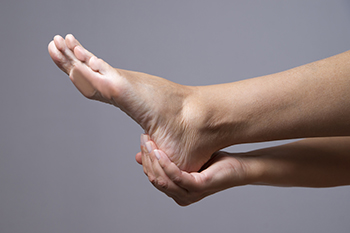
The arches of the feet work to transfer the weight from the heels to the toes when you walk. When the tendons and ligaments of the foot, which make up the arch, are inflamed they can cause pain and discomfort. The main type of arch pain comes from plantar fasciitis. The plantar fascia is a band of tissue that connects the toes to the heels, and it can become inflamed and painful. Another cause of arch pain is a bone fracture or sprained ligament. Arthritis and flat feet also may result in arch pain. The type and cause of the arch pain will dictate how to handle it. Grade 1 arch pain happens during activity. Grade 2 occurs before and after the activity but doesn’t impede the activity itself. Grade 3 arch pain occurs before, during, and after activity, and it also affects performance. Finally, with Grade 4 arch pain, activity is difficult, and pain is constant. For more information on how to deal with foot arch pain, it is suggested that you make an appointment with a podiatrist.
Foot Pain
Foot pain can be extremely painful and debilitating. If you have a foot pain, consult with one of our podiatrists from The Podiatry Center, PC. Our doctors will assess your condition and provide you with quality foot and ankle treatment.
Causes
Foot pain is a very broad condition that could be caused by one or more ailments. The most common include:
- Bunions
- Hammertoes
- Plantar Fasciitis
- Bone Spurs
- Corns
- Tarsal Tunnel Syndrome
- Ingrown Toenails
- Arthritis (such as Gout, Rheumatoid, and Osteoarthritis)
- Flat Feet
- Injury (from stress fractures, broken toe, foot, ankle, Achilles tendon ruptures, and sprains)
- And more
Diagnosis
To figure out the cause of foot pain, podiatrists utilize several different methods. This can range from simple visual inspections and sensation tests to X-rays and MRI scans. Prior medical history, family medical history, and any recent physical traumatic events will all be taken into consideration for a proper diagnosis.
Treatment
Treatment depends upon the cause of the foot pain. Whether it is resting, staying off the foot, or having surgery; podiatrists have a number of treatment options available for foot pain.
If you have any questions, please feel free to contact our office located in Millburn, NJ . We offer the newest diagnostic and treatment technologies for all your foot care needs.





